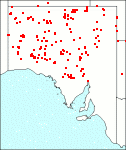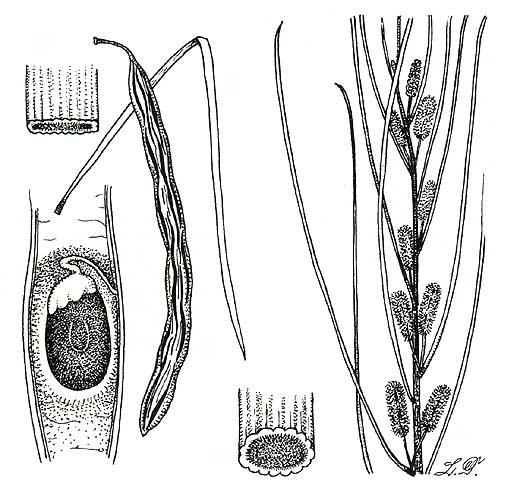Family: Fabaceae
Acacia ramulosa
Citation:
W. V. Fitzgerald, J.W. Aust. Nat. Hist. Soc. 2(1):15 (1905).
Derivation: ramulosus (L.)—having many branchlets.
Synonymy: Racosperma ramulosum (W.V. Fitzg.)Pedley, Austrobaileya 2:354 (1987).
Common name: horse mulga
Description:
Erect, much-branched, widely spreading, dull grey-green shrubs 2-6 m high and often the same or more across, branching into a number of slender stems terete, smooth, reddish-brown to grey; bark dark grey, rough at base of main stems.
Phyllodes linear, 8-20 cm long, 1.5-3 mm broad, erect, rigid, often terete, occasionally flat but thick, minutely pubescent, numerous fine parallel longitudinal veins visible under a lens, apex reddish-brown and tapering slightly into a blunt obtuse point which often seems to wither and break away; glands basal, small.
Inflorescences simple, 1-2 per axil; spikes dense, yellow, 1-2 cm long; peduncles usually hoary, 6-15 mm long; flowers 5-merous (sepals united at base).
Legumes cylindrical, 7-13 cm long, 5-8 mm diameter, hard and woody when mature, tapering slightly at both ends, hoary and marked with many brown resinous longitudinal veins, sometimes slightly constricted between the seeds. Seeds longitudinal in legumes, obloid; funicle filiform, short with 1-2 folds below the pale yellowish aril.
|
|
Distribution:
|
Scattered in the North-Western, Lake Eyre, Nullarbor, Gairdner-Torrens, Eyre Peninsula (northern part) regions, in open scrub to tall shrubland or low woodland, often associated with Acacia aneura and Casuarina cristata. Soils; mainly sandy calcareous. Rainfall 150-200 mm. Also W.Aust., N.T., Qld and N.S.W.
|
Flowering time: At irregular periods throughout the year.
|

SA Distribution Map based
on current data relating to
specimens held in the
State Herbarium of South Australia
|
Biology:
No text
Related taxa:
Very closely related to A. cibaria (sp. 112) and it is difficult to distinguish between the two species unless the legumes are present, A. cibaria has small turgid but flattish legumes (similar to A. aneura legumes but without wings). Acacia linophylla W. V. Fitzg (1904), is included by J. M. Black in Fl.S. Aust., Pt. 2:427 (1948) and is distinguished from A. ramulosa (sp. 107) by minor differences in the legumes. Specimens in the State Herbarium under A. ramulosa and A. linophylla cannot be satisfactorily distinguished at present. The distribution map covers all material in the State Herbarium that comes into this complex. Also refer to A. cyperophylla (sp. 106).
Taxonomic notes:
Four mistletoes have been collected on Acacia ramulosa but only a single collection of each, Amyema fitzgeraldii, pin-cushion mistletoe, A. gibberulum, A. maidenii, pale-leaved mistletoe and A. preissii, wire-leaved mistletoe.
Cultivation:
Suitable for planting in arid inland areas on sandy soils, useful for soil stabilisation and as a shelter belt species. Moderate to fast growth rate.
Author:
Not yet available
Source:

|

